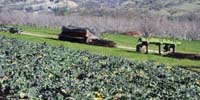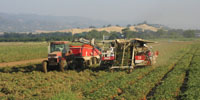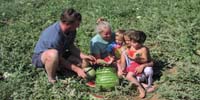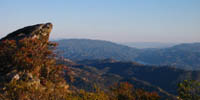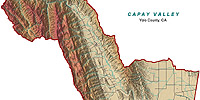about cvv | task forces | projects | press | publications | donate | gift shop| capay valley region | contact us | sitemap | home
email : info@capayvalleyvision.org telephone : (530) 723-4054 address : PO Box 799, Esparto, CA 95627
Capay Valley Region
The information presented in this section is excerpted from the Capay Valley Atlas written by Ann Scheuring and published by Capay Valley Vision in 2003.
General History
The Cache Creek watershed was home for Native American tribes for centuries before the Capay Valley entered modern history, but these indigenous and nomadic people left little physical evidence of their way of life. In 1846 the government of Mexico granted lands in the Capay Valley to three Berryessa brothers, beginning the period of settlement. Portions of this land grant were sold to Americans beginning in the 1850s. In 1887 land speculators organized the Capay Valley Land Company in conjunction with the construction of the Vaca Valley and Clear Lake Railroad, and subsequently this company and others divided up areas of the valley into parcels to sell to potential fruit farmers. The railroad served the valley from 1888 until the 1930s, while the valley was developed into various agricultural uses.
Natural Resources
All of western Yolo County's surface irrigation water supply passes through Cache Creek in the Capay Valley. Descending gradually from Lake County, the creek and its tributaries dominate the valley and have laid down varied alluvial soils and gravelly deposits. Mining of the gravel resources near Esparto over the last century has altered the native riparian environment there, and human activity in other parts of the valley has also changed the native vegetation, but many areas remain relatively pristine.
Wildlife abounds, particularly in the canyons, draws, and rangelands rising from the valley floor. Many varieties of birds inhabit or visit the area. Residents can frequently observe deer, skunks, rodents, and rattlesnakes; less often coyotes, opossums, beavers, and raccoon. Mountain lions and bear are present but rarely seen. Feral pigs have become a problem in recent years.
Agriculture and Current Land Uses
Agriculture in the Capay Valley has passed through several distinct phases, but remains the primary land use. The fruit colonies established around the turn of the century gradually declined because local climate and soils do not favor commercially dependable fruit production. Around 1920 some farmers began to plant almond orchards, a number of which have been converted over the years to walnuts. Other farmers continue to grow field crops, while ranchers continue to graze livestock in the hills. More than two dozen organic fruit and vegetable growers are currently expanding and diversifying their operations.
Most of the valley remains very rural-"the way California used to be," unpretentious and uncommercialized. The natural values of the area, particularly in the canyon upstream, are attracting a growing number of recreational rafters, hikers, birdwatchers, and campers.
Socio-Economic Profile
Regional population includes old-timers and retirees; conventional and organic farmers; hobby farmers and absentee landowners; small settlements of Mexican farm workers; and a number of residents committed to rural living while they commute to outside employment. A few black families have lived near Guinda for decades. The valley's main connection points are the post offices at Brooks, Guinda, and Rumsey; the fire stations; and the Brooks Mini-Mart. The unincorporated town of Esparto, which is the center of the unified school district, boasts a new (1999) branch of the Yolo County Library. Historic community halls in Rumsey and Guinda are currently undergoing renovation.
CVV makes extensive use of Adobe PDF documents. If you do not have the free Adobe Acrobat reader installed on your computer, you can click here to obtain your free copy.
Historical Timeline
The Cache Creek watershed supported Native American tribes for centuries before nineteenth-century European and American explorers and trappers began to move through the area in the 1830s. - more
Natural Resources
Since the 1850s Cache Creek has served as one of the state's oldest gravity-based water supply channels, bringing water from Clear Lake and its tributaries to Yolo County. - more
Agriculture and Current Land Uses
In many ways the Esparto-Capay Valley region is a microcosm of greater Yolo County, with a variety of soils and conditions supporting a diversified agriculture, from upland ranges to creekside terraces and flat plains. - more
Social Economics
Social statistics for the Esparto-Capay Valley region are compiled in the U.S. Census under the listing as Census Tract 115, Yolo County, California. In the 1990 census the total population of this tract was reported to be 3,673. - more
Photo Gallery
Take a virtual tour of beautiful Capay Valley by viewing our gallery of photographs from the region. - more



